1st Part
ANCIENT JEWELLERY EXHIBITED IN ANATOLIAN CIVILIZATIONS MUSEUM
Neck Jewellery
Pandatives
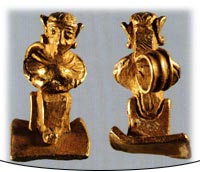 | Name: | Pandative small sculpture |
| Type: | Gold |
| Location where it came from: | Boğazköy, Kayalıboğaz |
| Way of Coming: | Exc. find |
| Dimensions: | H: 1.8cm W:0.9cm Depth:1.5cm |
| Weight: | 7.7 gr |
| Period | The Hittite Period |
A Goddess sitting in a kind of armchair on a rectangular base is holding a round based shallow pot. She has a roman nose and big ears. There are disk shaped earrings on the ears. The hair is left long on the back. She has a cap like a skullcap on her head and her dress goes down to her feet. She wears shoes with twisted ends. It is solid cast. It has a string or a large ring for the chain at the back.
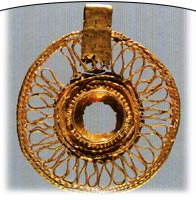 | Name: | Pandatif |
| Type: | Gold |
| Location where it came from: | Kültepe, Grave |
| Way of Coming: | Exc. find |
| Dimensions:: | H:4.3cm W:2.7 cm |
| Weight: | 3.69 gr. |
| Period: | The Asur Trade Colonies Period |
It is a disk -shaped pandantive made with a filigree technique. The perimetre of the slot, a stone in the middle of which has fallen, is limited with two rows of grooved wire with the wavy ornament made with thin wire in between.
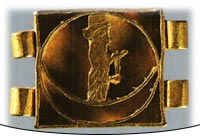 | Name: | Pandative |
| Type: | Altın |
| Location where it came from: | Yozgat |
| Way of Coming: | Not known |
| Dimensions:: | L:2cm W:1.4cm |
| Weight: | 4 gr. |
| Period: | The Greco-Persian |
A golden frame is made to the edges of a golden rectangular plate with the same thickness as the plate. A round band is placed in the internal side so that it touches the frame on the edges. A crescent is made with another concave band in the lower half of this ellipsoid band. A men figure is standing on a crescent, in the middle, turned to the left. The figure is attached to a rectangular plate below it, and this way it has brought to the same level with the frames. The figure is also cut from the golden sheet. His eye, polo, cloth folds are shown with carved lines. Although he is shown from the profile, his eye is on the front. The right arm is bent from the elbow, the hand is open and directed forward and he holds something in his left hand. He is a Persian as understood from his polo and coat. There are two vertical flat handles on the short edges of the plate.
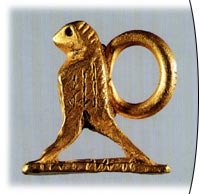 | Name: | Pandative |
| Type: | Gold |
| Location where it came from: | Milas |
| Way of Coming: | Confiscation |
| Dimensions:: | L: 1cm W:0.9cm |
| Weight: | 1.55 gr. |
| Period: | The 5th century BC |
It is a pandantif in the form of a predatory bird (falcon) made with a mould casting technique. The predatory bird stands on a rectangular base and the end of its tail is soldered to this base. The eyes and wings are indicated by drawing. It has a big handle on its back.
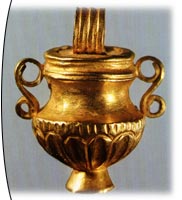 | Name: | Pandative |
| Type: | Gold |
| Location where it came from: | Gediz |
| Way of Coming: | Not known |
| Dimensions:: | H:2.25cm W:1.85cm |
| Weight: | 4.7 gr |
| Period: | The 3rdcentury BC |
It is a necklace piece in a form of a crater. It has leaf - shaped ornaments towards the base. The handles are sharp profiled and show an "S" spiral form. The lip is grooved horizontally. The grooved and wide ring is attached to the cover of the crater and the mouth edge of the crater is closed over this cover by twisting.
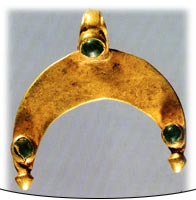 | Name: | Pandative (lunula) |
| Type: | Gold and glass |
| Location where it came from: | Not known |
| Way of Coming: | Confiscation |
| Dimensions:: | H:2.3cm W:2.3 cm |
| Weight: | 2.25 gr |
| Period: | The 1-3rd century AD |
The crescent, which is the symbol of a moon god, is used as a necklace pandantif. The triangular projections on both ends of the pandantif which is cut from a solid golden plate and formed as a moon are added to the lunula with solder. Lunula is ornamented with green glasses placed in the wire slots on both ends and in the middle of the handle.